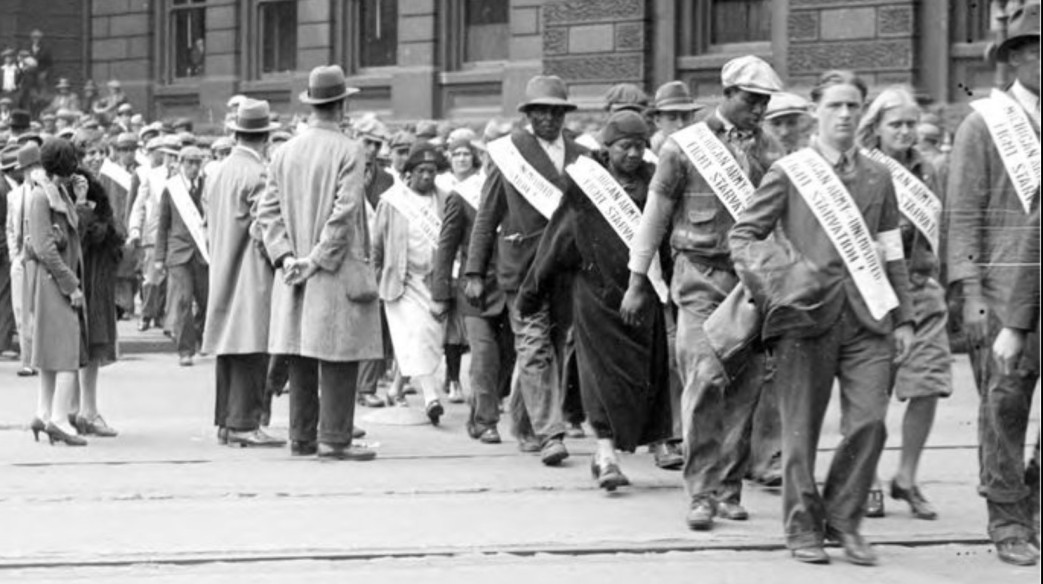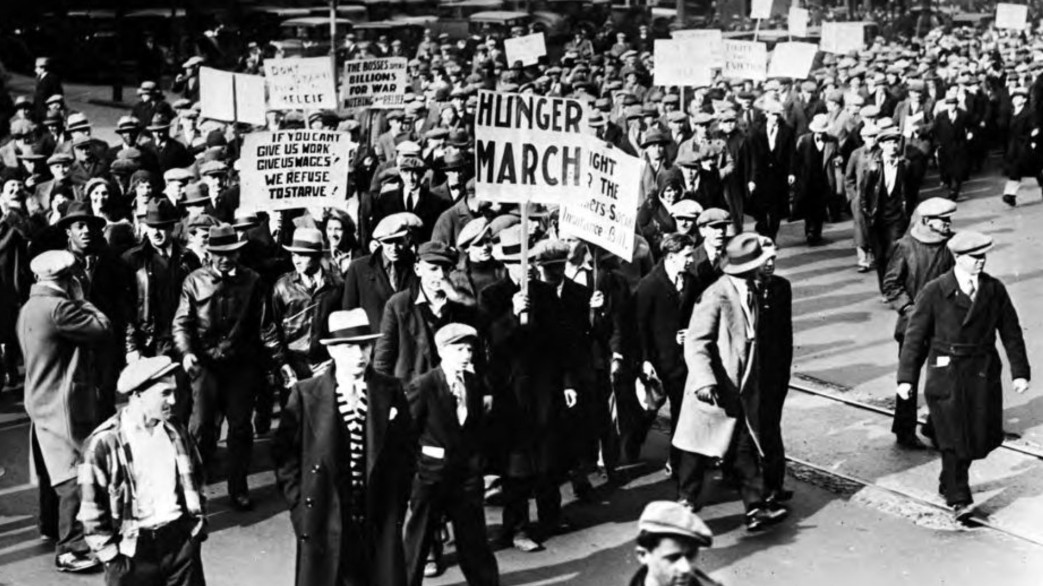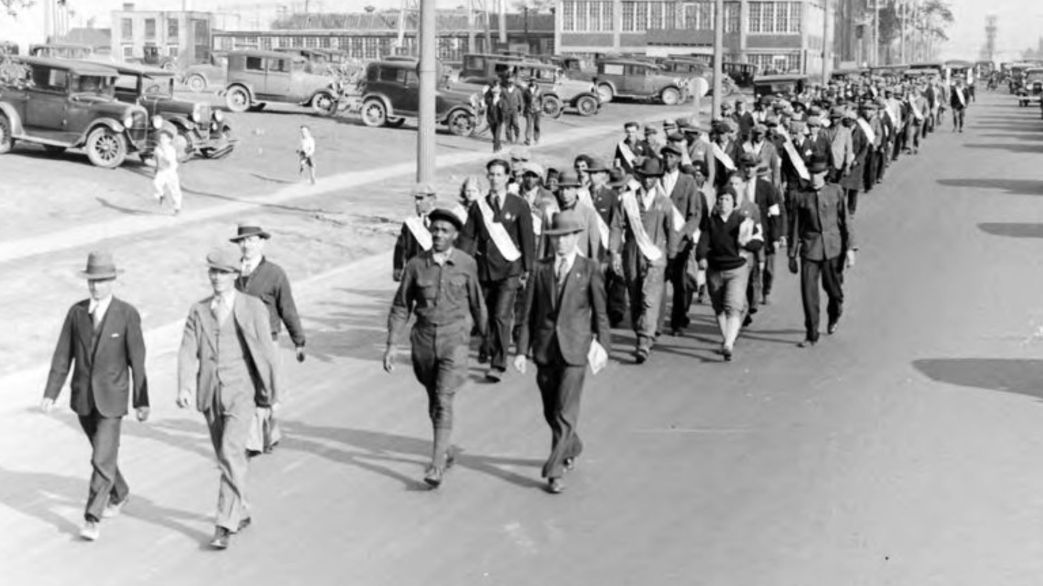Fighting for relief, against Jim Crow, eviction and hunger. Details of the Detroit Communist Party’s effort in building mutual aid during the Great Depression.
‘How Unemployed Council Block Committees are Organized in Detroit’ by A. Gerlach from the Daily Worker. Vol. 8 No. 195. August 14, 1931.
SINCE the March, 1930, demonstration of the Unemployed in Detroit, where over 100,000 workers participated, we have tried to build Unemployed Councils in 3 or 4 different neighborhood sections.
Until 4 months ago, we did not succeed in getting a real council under way. Leaflet form calls were issued for meetings and distributed; some workers would come, listen to our speakers (and there were plenty and long-drawn-out ones) sign applications, join the councils, attend 2 or 3 meetings and drop out. This fluctuation of members has continued for months. There was no real life in the Unemployed Councils.
With the election of Mayor Murphy, the flop houses were established. Groups were organized on the inside, good demonstrations were held, and at one time, we succeeded in having our demands for management of the flop house granted. The flop house was managed for a few days by a committee of workers living inside, but for the lack of continuous attention by the comrades in charge (when the demands were granted, we thought that this was all that was needed) the city welfare commission thru its agents, succeeded in getting the workers organized against their own management committee and voted that the management be turned back to the administration. This was the end of our organized group in the flop house.
On the fight against evictions, we have been able to mobilize thousands of workers, especially in the Negro workers’ neighborhoods, as they were the hardest hit. The reasons for our successes were that here we had something concrete to fight for, but still the membership in the Unemployed Council was dropping out rapidly.
After continuous attempts to organize councils by leaflet calls, some comrades got disgusted and started a new form of work among the unemployed. Blanks were made by the TUUL office (Unemployed Section) for investigation of the starving families of workers. This was one step forward, because it gave us a clear picture of the sufferings the workers are actually confronted with.
In a given block, in the “black belt,” a worker was visited and permission gotten to hold a meeting in his home. After the workers in the block were visited, unemployment was discussed with them, and they were invited to the meeting. At the meeting, individual cases were discussed, a number of families picked out, a committee elected and with the names of the families, the welfare department was visited. At the welfare department, demands were made for food, rent, coal and all other necessities. In most cases, demands made by the committee were granted. This was the laying of the basis of the organization of block committees. The block committees were springing up like mushrooms.
At the present time have block committees, 17 of these are functioning well with an average membership of from 15 to 60 members in one neighborhood. The total number of block committees at present in Detroit is 45, with a membership of over 2,500, although not all members of the block committee are in the Unemployed Council proper, but work under the guidance of same.
Each block committee has a captain, who is in contact with the membership and at the same time with the comrade in charge of the Unemployed Council. Through this system, we are able to organize from 3 to 7 thousand workers in 2 or 3 hours. The block committees are the most effective weapon in the fight against evictions. If an eviction takes place in a certain neighborhood (especially Negro neighborhood where 31 block committees are organized) a worker would call up the TUUL office or the Unemployed Council headquarters, and report the place of the eviction, from where contacts would be made with the captains of the block committees who would mobilize their members and other workers from the neighborhood, and go out to the place of the eviction ready to put the furniture back into the house, even to the extent of fighting it out with the police. Two incidents are especially important to mention.
An eviction took place 3 weeks ago, on a certain street. The block committees were mobilized and 2,000 workers in the time of 2 hours came to put the furniture back into the house. The police came. One cop on a motorcycle tried to ride through the crowd of workers on the sidewalk. The result was, the cop had to fractured skull, leg broken and was taken to the hospital; 30 workers were arrested after a fight and some were railroaded to 10 days in jail, others receiving suspended sentence.
Another eviction took place 3 days later. The block committees mobilized in 3 hours time over 3,000 workers at 7 p.m., and by 11 p.m. over 7,000 workers were at the scene. A squad of policemen, the black hand squad, were lined up on the porch of the house, from where the worker as evicted with drawn guns, keeping the crowd of workers from putting the furniture back into the house. Boos, catcalls, etc., could be heard during the time of the presence of the police. 18 workers were arrested at this eviction. The crowd of 3,000 stood around until 3 a.m.
All this was a positive contributing factor to the mobilization of our Scottsboro and also August 1st demonstrations.
These block committees of the Unemployed. Councils are very effective in our fight against the liberal Murphy administration, both on the relief and eviction cases, because the workers can see and feel the leadership of our Party. Many good working class fighters from these block committees are joining the Party. This is the good side of our work among the unemployed. Now we will bring out the bad side
All of this work, of the organization of block committees was carried on by 7 or 8 comrades. In Detroit, we have now 5 unemployed council branches functioning well with a membership of about 3,000 workers, then we have 4 or 5 Unemployed Councils just beginning to function with small membership. In not a single council did we have a Party fraction functioning (until a week ago) and in the block committees, not only do we have no fractions functioning but in many of the block committees we don’t have a single member, or if we have one or two, they are very new and inexperienced workers, as far as the Communist movement is concerned. Many an old Party member is willing to pay 10 cents dues a week in order not to be considered “unemployed” and to get away from attending meetings of the Unemployed Councils or the Block Committees. While the comrades who are new in the Party, and joined through Unemployed Council activities, are doing unemployed work only (only naturally so) but have no experience in the work of how to carry on Communist activities in the Unemployed Council.
This is one danger–the danger of the Unemployed Council getting a real mass basis–slipping away and getting under control of our enemies.
Another danger is, that the Unemployed Councils in the “black belt” become jim-crow organizations. In the 31 block committees we have only 3 or 4 white workers working actively. The Unemployed Council at the Workers Home has about 1,000 members–only 3 or 4 white members. All others are Negroes, men and women. Because of our tremendous influence and organization among the Negro workers, the Negro bourgeoisie is carrying on a strong propaganda in the Negro newspapers against our Party and the Unemployed Council. They are sending Negro stool pigeons into the meetings of the Unemployed Councils who are attacking the Communist Party as an organization of “white men” who want to “use the Negro” for their own political purposes.” This is not effective yet, but will be, if our leading Party committees do not take sharp measures to have the white comrades become active in the next week or two. These stool-pigeons are not only being sent to the meetings of the Unemployed Council proper, but also into the block committees, where they get away with many things, because of the absence of Party members. There is a real actual danger of the block committees and some branches of the Unemployed Council becoming tools in the hands of our enemies.
The main reason for the non-functioning of our fractions lays in the fact that our leading committees of the district have underestimated the radicalization of the workers, both white and Negro, did not pay enough attention to the Section Committees and Unit Buros. Only now, when there is an actual danger of losing control of the Unemployed Councils and the Block Committees, did we wake up and start a real drive for the organization of the fractions in the Unemployed Councils and Block Committees.
A strict check-up on every individual member of every nucleus is being carried on at the next unit meeting. Drastic steps are being taken to have every unemployed Party member (regardless of his dues payments!) attend fraction meetings and the meetings of the block committees and the Unemployed Council branches, not necessarily giving all his or her time to this work, but to devote part time, be present at regular meetings in an organized manner, as there are hundreds of non-Party members in the Unemployed Council working actively every day, to see that the Party line is carried out.
The Daily Worker began in 1924 and was published in New York City by the Communist Party US and its predecessor organizations. Among the most long-lasting and important left publications in US history, it had a circulation of 35,000 at its peak. The Daily Worker came from The Ohio Socialist, published by the Left Wing-dominated Socialist Party of Ohio in Cleveland from 1917 to November 1919, when it became became The Toiler, paper of the Communist Labor Party. In December 1921 the above-ground Workers Party of America merged the Toiler with the paper Workers Council to found The Worker, which became The Daily Worker beginning January 13, 1924.
PDF of full issue: https://www.marxists.org/history/usa/pubs/dailyworker/1931/v08-n195-NY-aug-14-1931-DW-LOC.pdf


